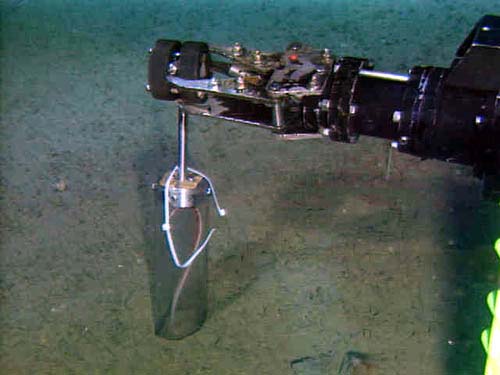3.4: Reconstructing Earth history
- Page ID
- 781
\( \newcommand{\vecs}[1]{\overset { \scriptstyle \rightharpoonup} {\mathbf{#1}} } \)
\( \newcommand{\vecd}[1]{\overset{-\!-\!\rightharpoonup}{\vphantom{a}\smash {#1}}} \)
\( \newcommand{\id}{\mathrm{id}}\) \( \newcommand{\Span}{\mathrm{span}}\)
( \newcommand{\kernel}{\mathrm{null}\,}\) \( \newcommand{\range}{\mathrm{range}\,}\)
\( \newcommand{\RealPart}{\mathrm{Re}}\) \( \newcommand{\ImaginaryPart}{\mathrm{Im}}\)
\( \newcommand{\Argument}{\mathrm{Arg}}\) \( \newcommand{\norm}[1]{\| #1 \|}\)
\( \newcommand{\inner}[2]{\langle #1, #2 \rangle}\)
\( \newcommand{\Span}{\mathrm{span}}\)
\( \newcommand{\id}{\mathrm{id}}\)
\( \newcommand{\Span}{\mathrm{span}}\)
\( \newcommand{\kernel}{\mathrm{null}\,}\)
\( \newcommand{\range}{\mathrm{range}\,}\)
\( \newcommand{\RealPart}{\mathrm{Re}}\)
\( \newcommand{\ImaginaryPart}{\mathrm{Im}}\)
\( \newcommand{\Argument}{\mathrm{Arg}}\)
\( \newcommand{\norm}[1]{\| #1 \|}\)
\( \newcommand{\inner}[2]{\langle #1, #2 \rangle}\)
\( \newcommand{\Span}{\mathrm{span}}\) \( \newcommand{\AA}{\unicode[.8,0]{x212B}}\)
\( \newcommand{\vectorA}[1]{\vec{#1}} % arrow\)
\( \newcommand{\vectorAt}[1]{\vec{\text{#1}}} % arrow\)
\( \newcommand{\vectorB}[1]{\overset { \scriptstyle \rightharpoonup} {\mathbf{#1}} } \)
\( \newcommand{\vectorC}[1]{\textbf{#1}} \)
\( \newcommand{\vectorD}[1]{\overrightarrow{#1}} \)
\( \newcommand{\vectorDt}[1]{\overrightarrow{\text{#1}}} \)
\( \newcommand{\vectE}[1]{\overset{-\!-\!\rightharpoonup}{\vphantom{a}\smash{\mathbf {#1}}}} \)
\( \newcommand{\vecs}[1]{\overset { \scriptstyle \rightharpoonup} {\mathbf{#1}} } \)
\( \newcommand{\vecd}[1]{\overset{-\!-\!\rightharpoonup}{\vphantom{a}\smash {#1}}} \)
\(\newcommand{\avec}{\mathbf a}\) \(\newcommand{\bvec}{\mathbf b}\) \(\newcommand{\cvec}{\mathbf c}\) \(\newcommand{\dvec}{\mathbf d}\) \(\newcommand{\dtil}{\widetilde{\mathbf d}}\) \(\newcommand{\evec}{\mathbf e}\) \(\newcommand{\fvec}{\mathbf f}\) \(\newcommand{\nvec}{\mathbf n}\) \(\newcommand{\pvec}{\mathbf p}\) \(\newcommand{\qvec}{\mathbf q}\) \(\newcommand{\svec}{\mathbf s}\) \(\newcommand{\tvec}{\mathbf t}\) \(\newcommand{\uvec}{\mathbf u}\) \(\newcommand{\vvec}{\mathbf v}\) \(\newcommand{\wvec}{\mathbf w}\) \(\newcommand{\xvec}{\mathbf x}\) \(\newcommand{\yvec}{\mathbf y}\) \(\newcommand{\zvec}{\mathbf z}\) \(\newcommand{\rvec}{\mathbf r}\) \(\newcommand{\mvec}{\mathbf m}\) \(\newcommand{\zerovec}{\mathbf 0}\) \(\newcommand{\onevec}{\mathbf 1}\) \(\newcommand{\real}{\mathbb R}\) \(\newcommand{\twovec}[2]{\left[\begin{array}{r}#1 \\ #2 \end{array}\right]}\) \(\newcommand{\ctwovec}[2]{\left[\begin{array}{c}#1 \\ #2 \end{array}\right]}\) \(\newcommand{\threevec}[3]{\left[\begin{array}{r}#1 \\ #2 \\ #3 \end{array}\right]}\) \(\newcommand{\cthreevec}[3]{\left[\begin{array}{c}#1 \\ #2 \\ #3 \end{array}\right]}\) \(\newcommand{\fourvec}[4]{\left[\begin{array}{r}#1 \\ #2 \\ #3 \\ #4 \end{array}\right]}\) \(\newcommand{\cfourvec}[4]{\left[\begin{array}{c}#1 \\ #2 \\ #3 \\ #4 \end{array}\right]}\) \(\newcommand{\fivevec}[5]{\left[\begin{array}{r}#1 \\ #2 \\ #3 \\ #4 \\ #5 \\ \end{array}\right]}\) \(\newcommand{\cfivevec}[5]{\left[\begin{array}{c}#1 \\ #2 \\ #3 \\ #4 \\ #5 \\ \end{array}\right]}\) \(\newcommand{\mattwo}[4]{\left[\begin{array}{rr}#1 \amp #2 \\ #3 \amp #4 \\ \end{array}\right]}\) \(\newcommand{\laspan}[1]{\text{Span}\{#1\}}\) \(\newcommand{\bcal}{\cal B}\) \(\newcommand{\ccal}{\cal C}\) \(\newcommand{\scal}{\cal S}\) \(\newcommand{\wcal}{\cal W}\) \(\newcommand{\ecal}{\cal E}\) \(\newcommand{\coords}[2]{\left\{#1\right\}_{#2}}\) \(\newcommand{\gray}[1]{\color{gray}{#1}}\) \(\newcommand{\lgray}[1]{\color{lightgray}{#1}}\) \(\newcommand{\rank}{\operatorname{rank}}\) \(\newcommand{\row}{\text{Row}}\) \(\newcommand{\col}{\text{Col}}\) \(\renewcommand{\row}{\text{Row}}\) \(\newcommand{\nul}{\text{Nul}}\) \(\newcommand{\var}{\text{Var}}\) \(\newcommand{\corr}{\text{corr}}\) \(\newcommand{\len}[1]{\left|#1\right|}\) \(\newcommand{\bbar}{\overline{\bvec}}\) \(\newcommand{\bhat}{\widehat{\bvec}}\) \(\newcommand{\bperp}{\bvec^\perp}\) \(\newcommand{\xhat}{\widehat{\xvec}}\) \(\newcommand{\vhat}{\widehat{\vvec}}\) \(\newcommand{\uhat}{\widehat{\uvec}}\) \(\newcommand{\what}{\widehat{\wvec}}\) \(\newcommand{\Sighat}{\widehat{\Sigma}}\) \(\newcommand{\lt}{<}\) \(\newcommand{\gt}{>}\) \(\newcommand{\amp}{&}\) \(\definecolor{fillinmathshade}{gray}{0.9}\)Ocean sediments can help us reconstruct Earths history. The sediments deposited on the ocean floor often have markers of the Earths environment when they were deposited and can tell us a lot about how the environment of our planet has changed throughout its history. Scientists have used sediment cores, long vertical tubes of sediment drilled from the bottom of the ocean, to estimate how the ocean reacts to global temperature changes. This is an invaluable tool in understanding what to expect in the future and to help us learn about our past

webapp1.dlib.indiana.edu/virt...diment_500.jpg
Oceanographers know about past climates and weathers by studying foraminifera that can be found in ocean sediments. Foraminifera, also known as forams, have shells that are made of calcium carbonate which can explain how past climate were by showing how much “the oxygen in the carbonate reflects the isotopic abundance in the shallow waters where the creatures lived” (Past Climates). As their shell dissolves when they sink further down, it withholds and contains isotopic oxygen. The ratio between these two oxygen isotopes, oxygen 18 and oxygen 16, can tell us the temperature in the Cretaceous Period. Oxygen 18 is known as the heavier oxygen and oxygen 16 is known as the lighter oxygen. When there is more oxygen 18 found in foram shells, the weather is usually warmer because the lighter oxygen is easier and takes less energy to evaporate than the heavier oxygen, so the heavier oxygen usually gets left behind in warmer temperatures. It is said that “only a tiny 0.2 parts per million decrease [in oxygen 16 will result] for each degree of temperature increase” (NASA). From the ratios of the isotopes, we are able to see that during the Cretaceous Period, the temperature was about 10-15 degrees Celsius warmer than today which shows that there were no ice glaciers millions of years ago. Also, paleoclimatologists study the layers of sediment called varve which are fine deposited silt or clay. The layer of varve is able to tell us temperatures, amount of rainfall, and amount of snow fall years ago.
Another way of examining the weather/climate years ago is through studying ice cores. Ice cores can help us predict the abundance of greenhouse gases. Paleoclimatologist studies greenhouse gases and atmospheric temperatures by studying the bubbles trapped in ice cores. After obtaining the cross-section from the ice sheet, they bring it back to the laboratory and heat it “carefully in a vacuum chamber (to avoid contamination by modern air), releasing the ancient air for analysis” (Past Climates). From the analysis, it is observed that methane barely changed over the course of 160,000 years, “staying to about 750 parts per billion” until the 1970’s when the industrial revolution began ( Past Climates ) which paleoclimatologists believe caused Earth to begin increasing in temperature. Information from ice cores can tell us many facts about past climates. When examining the ice core, the light bands in it corresponds to summer/warmer weather and darker bands corresponds to winter where there is more wind and dust blown from on land. We can see these bands with the naked eye. Also, thick layers of greater snow leads to a heavier winter. Examining trapped bubbles in ice cores, we see that certain elements corresponds to certain effects of the climate. For example, with more beryllium-10 concentrations, there was more solar radiation.
Resource: www.globalchange.umich.edu/gl...g/paleoclimate
Picture: jonova.s3.amazonaws.com/graph...-10000-new.png

